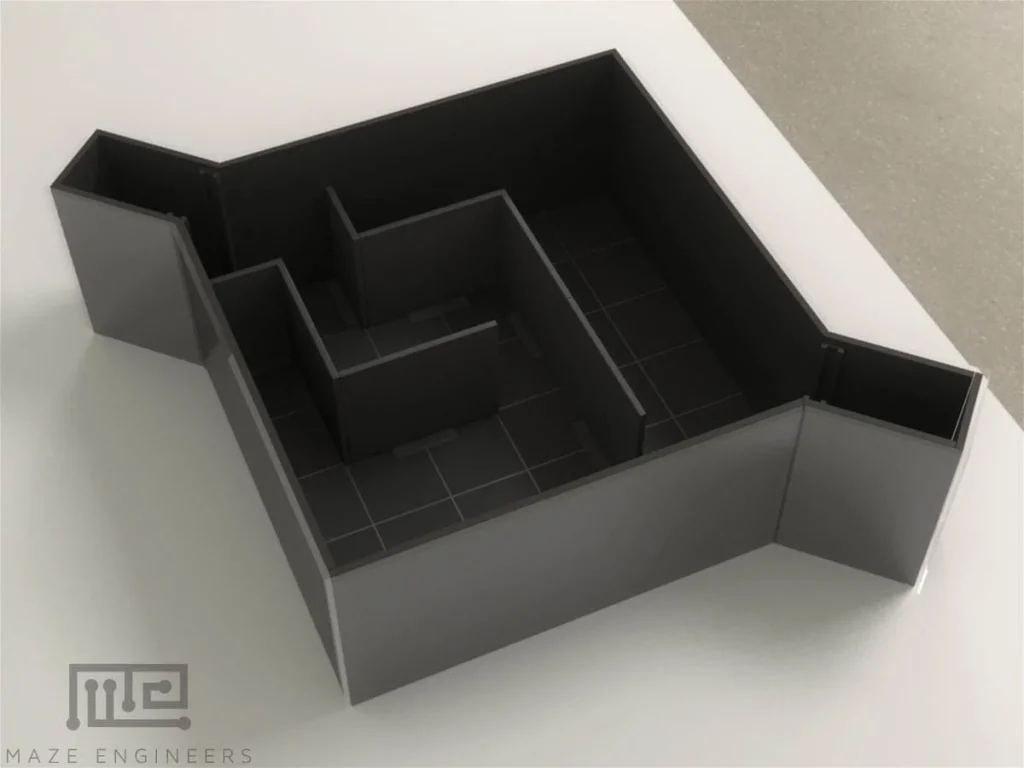The Hebb-Williams Maze
Mazes are among the most popular behavioral tests used by researchers working with rodents. Numerous varieties of mazes exist to investigate different aspects of spatial learning, memory, intelligence, and other rodent behaviors. As with any research tool, it is crucial to choose the maze that best fits the specific requirements of an experiment. If your study aims to incorporate an element of problem-solving, the Hebb-Williams Maze is an excellent choice.
The Hebb-Williams Maze is a well-known apparatus used in cognitive and behavioral research, particularly in studies involving rodents. Developed in the mid-20th century, this maze allows researchers to assess spatial learning, memory, and problem-solving abilities in animals. The maze’s design, inspired by the work of Donald Hebb and Kenneth Williams, has become a staple in neuroscience research due to its versatility and effectiveness (1).
Figure: The Hebb-Williams Maze
The Basics
The Hebb-Williams Maze consists of a series of enclosed pathways with various obstacles and turns. Unlike simpler mazes such as the T-maze or the Radial Arm Maze, the Hebb-Williams Maze offers more complex and varied configurations. This complexity enables researchers to study more nuanced aspects of cognition, including how animals adapt to changing environments and solve new problems (2). The Hebb-Williams Maze was originally designed as a test of intelligence in rats, though it is also commonly adapted for use with mice.
It features a square arena with fixed start and finish points located in the same corners for each trial. The interior of the arena, however, is dynamic, with a new arrangement of walls assembled for each test. This design ensures that subjects must rely on their understanding of the start and end locations to navigate the changing interior. To standardize the testing conditions, Rabinovitch and Rosvold created a set of pre-designed interior mazes in 1951, resulting in a battery of standardized mazes that are still widely used today (2).
Specifications of the Arena
The Hebb-Williams Maze typically comprises a square or rectangular arena divided into several interconnected sections. Each section can be rearranged to create different maze patterns, allowing for a wide range of experimental conditions. The walls of the maze are usually made of opaque materials to prevent visual cues from influencing the animals’ behavior (3).
Key specifications include:
- Dimensions: The size of the maze can vary, but a common setup involves a 1.5-meter by 1.5-meter arena.
- Material: The walls are typically constructed from materials like Plexiglas or wood.
- Modularity: The maze sections can be reconfigured to create different patterns.
- Lighting: Consistent lighting is crucial to avoid influencing the animals’ performance through visual stressors.
The start and goal boxes should be placed at opposite corners of the maze and remain fixed in those positions throughout the experimentation period.
The interior walls, made of the same opaque material as the exterior walls, should be moveable to allow for different configurations. While the floor of the maze arena is often made of transparent Plexiglas, and a transparent lid can be used, it is essential that the walls remain opaque to prevent visual cues from influencing the subjects’ behavior.
How it works
Hebb-Williams maze experiments are conducted in three phases: acclimation, acquisition, and testing.
During the acclimation or habituation phase, the animal is introduced to the arena. This phase, common to many behavioral tests, involves placing the animal in the arena, consistently facing the same direction for all testing phases, and allowing it to explore the arena without any interior walls for about 5-10 minutes (4).
After several habituation trials in an empty arena, a food reward is introduced in the goal box for additional “baited” habituation trials. This phase typically lasts 3-4 days, beginning with un-baited trials and concluding with baited ones. Once the animal is sufficiently acclimated to the arena and the reward box, the next phase can commence.
The acquisition phase is the first experimental phase utilizing the interior walls of the maze. Rabinovitch and Rosvold’s standardized set includes six simple acquisition mazes (A-F) designed to help animals learn maze navigation.
Mazes are generally run in a consistent order during two sessions per day. Food rewards are used, but care is taken not to overfeed (approximately 10mg of reward is sufficient for mice). Each acquisition session usually consists of around nine trials. The order of mazes can be A-B-C-D-E-F or similar sequences (4).
These acquisition trials are timed, and if an animal does not reach the goal within 300 seconds, an opaque Plexiglas piece is used to guide it to the finish. The acquisition phase is complete when an animal can complete the nine trials in under a minute for two consecutive sessions. The number of sessions required to reach this criterion is noted for each animal.
If only a few animals in a cohort do not meet the criterion, it is not necessary to run all animals in every session. The performance of other animals is maintained by running them a few sessions per week until all animals meet the criterion.
Once all animals have met the criterion, the testing phase begins. This phase involves twelve standardized mazes (1-12), tested in the same order for all subjects. Unlike the acquisition phase, only one maze is used per session. Each subject undergoes about five trials per session with a given maze.
After each trial, the animal is given time to enjoy its reward before being transported back to the start in a small container. After five trials, the animal is returned to its home cage.
How does the Scoring work?
In the acquisition phase, the main performance metrics are the time taken to complete the maze and the number of sessions required to meet the criterion. Many mazes are equipped with infrared beams in the start and end boxes to precisely measure trial time.
During the testing phase, the primary measure of performance is not always the time taken to reach the goal, as this can sometimes reflect locomotive capabilities more than spatial learning (4). However, recording the time to goal is still standard practice. The number of errors made is often the primary scoring metric. An error is defined as any entry into a part of the maze that does not lead to the goal box. Other behaviors, such as pauses, should be recorded but are not counted as errors.
A successful trial is characterized by the rodent navigating the maze quickly and without errors. As with many behavioral tests, automated scoring programs can assist with evaluation, but many researchers also choose to manually score behavior to ensure accuracy.
To conclude, scoring in Hebb-Williams Maze experiments is based on several parameters:
- Latency: The time it takes for the animal to reach the goal.
- Errors: The number of wrong turns or entries into dead ends.
- Path Efficiency: The directness of the path taken by the animal to reach the goal compared to the optimal path.
These metrics help researchers evaluate the cognitive abilities of the subjects, such as their learning speed, memory retention, and problem-solving skills (5).
Versatile Testing Tool
Like many behavioral tests, the Hebb-Williams Maze can be utilized to evaluate problem-solving differences among various rodent strains, drug treatments, and disease models, among other experimental manipulations. One of the most remarkable features of the Hebb-Williams Maze is its suitability for cross-species application.
It is commonly employed to study:
- Spatial Learning and Memory: Assessing how animals remember and navigate the maze.
- Cognitive Flexibility: Testing how animals adapt to changes in the maze configuration.
- Neuropharmacology: Evaluating the effects of drugs on cognitive functions.
- Genetics: Investigating the impact of genetic modifications on behavior.
A persistent challenge in rodent behavioral research is generalizing the results from rodent tests to human conditions and behavior. In 2001, Shore and colleagues addressed this by developing a virtual Hebb-Williams Maze, enabling researchers to compare rodent performance on the physical maze with human performance on a virtual version (6).
Conclusion
The Hebb-Williams Maze is very important in the field of cognitive and behavioral research, particularly for studies involving rodents. Its design allows for the assessment of spatial learning, memory, and problem-solving abilities, making it a versatile and robust method for a wide range of experimental applications. Innovations such as the virtual Hebb-Williams Maze facilitate cross-species comparisons, enhancing the relevance of rodent studies to human conditions.
Tests with cross-species validity have gained popularity because they offer a more accurate representation of human conditions and learning mechanisms. The Hebb-Williams Maze stands out as it is sensitive to a variety of natural and manipulated factors, such as sex, environmental enrichment, drug administration, and genetic modifications. This makes the Hebb-Williams Maze an excellent candidate for cross-species assessments of problem-solving and intelligence.
References
- Hebb, D. O., & Williams, K. (1946). A method of assessing animal intelligence. Journal of Comparative and Physiological Psychology.
- Rabinovitch, M. S., & Rosvold, H. E. (1951). A closed-field intelligence test for rats. Canadian Journal of Psychology, 5(122), 122-128.
- Kolb, B., & Whishaw, I. Q. (2008). Fundamentals of human neuropsychology (6th ed.). Worth Publishers.
- Stanford, L., & Brown, R. E. (2003). MHC-congenic mice (C57BL/6J and B6-H-2K) show differences in speed but not accuracy in learning the Hebb-Williams Maze. Behavioural Brain Research, 144, 187-197.
- Whishaw, I. Q., & Kolb, B. (2004). The behavior of the laboratory rat: A handbook with tests. Oxford University Press.
- Shore, D. I., Stanford, L., MacInnes, W. J., Klein, R. M., & Brown, R. E. (2001). Of mice and men: Virtual Hebb-Williams mazes permit comparison of spatial learning across species. Cognitive, Affective, & Behavioral Neuroscience, 1(1), 83-89.
See more of Our Posts
Behavioral neuroscience
All Resources
Never miss our posts!
Author:

Louise Corscadden, PhD
Dr Louise Corscadden acts as Conduct Science’s Director of Science and Development and Academic Technology Transfer. Her background is in genetics, microbiology, neuroscience, and climate chemistry.

